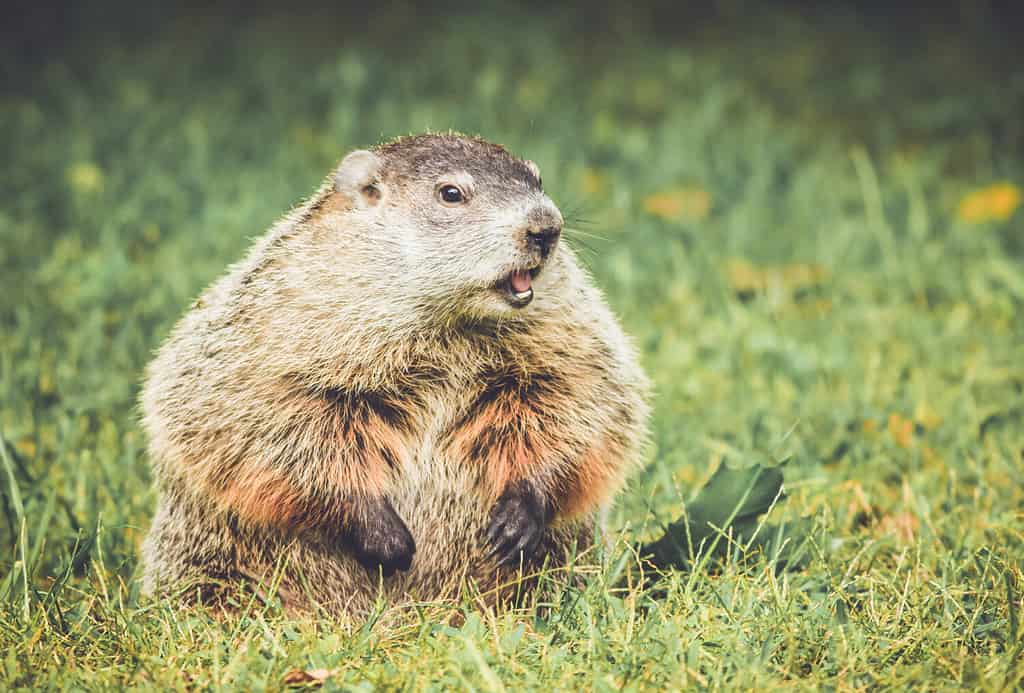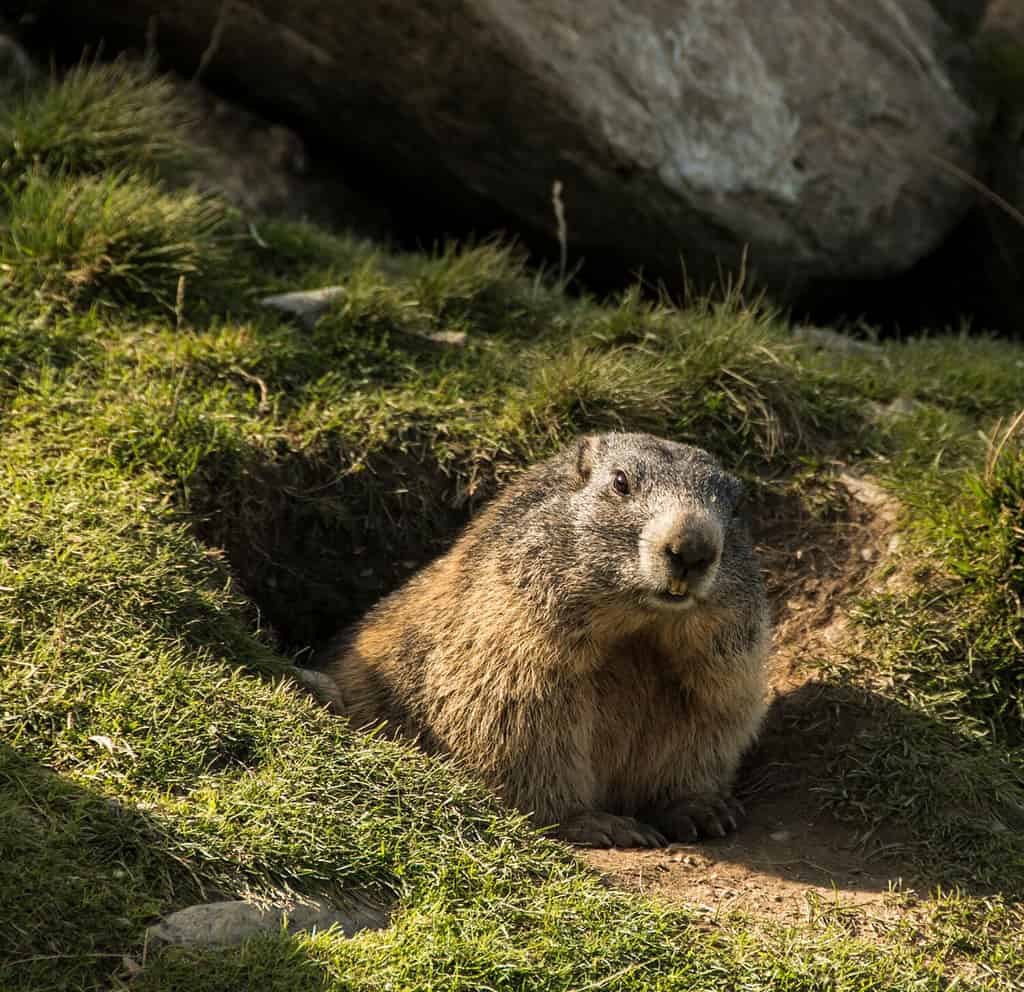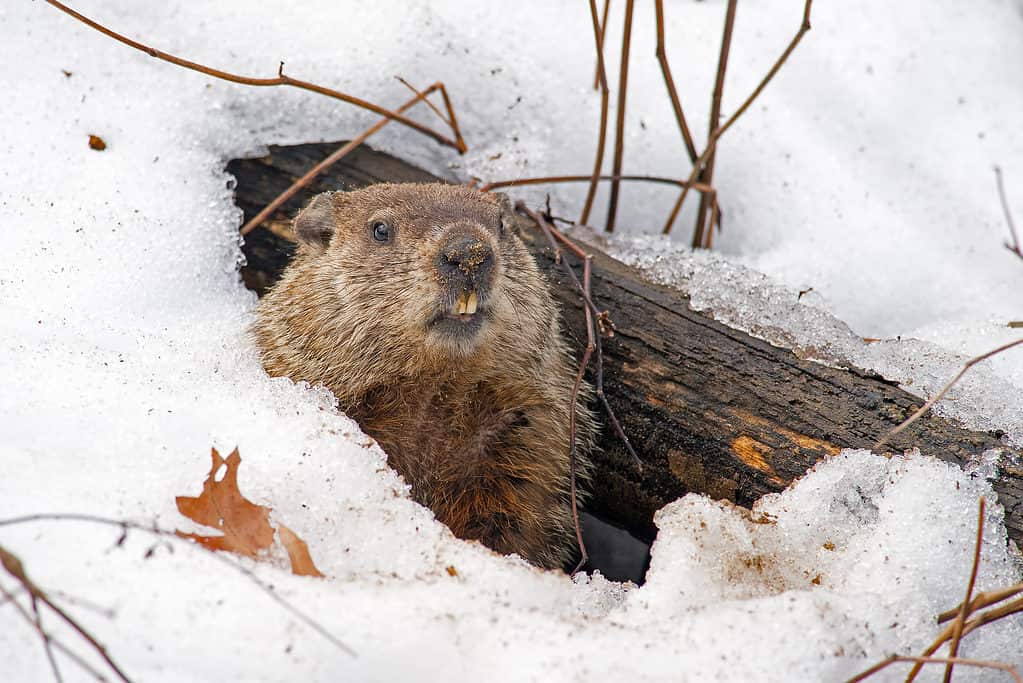Like other members of the Scuiridae squirrel family, woodchucks (Marmota monax) are great climbers. Woodchucks do not make their homes up in trees. Instead, these big rodents are members of the ground squirrel genus Marmota, preferring to keep their feet firmly on the earth.
Woodchucks are also known vernacularly as whistle pigs and groundhogs, and the names are apt. When threatened, woodchucks make high-pitched whistling noises to warn other whistle pigs of the perceived danger. And while they can climb (and swim!), they are more commonly found on the ground.
Whatever you call them, woodchucks are prevalent across about half of North America. But where exactly do woodchucks live? The groundhog nomenclature gives the greatest clue about where woodchucks live: in the ground.
Woodchuck Range

The woodchuck is a large rodent that weights up to 14 pounds.
©Rabbitti/Shutterstock.com
Woodchucks are a lowland animal and are found throughout the eastern and Midwest United States, from Maine to northern Georgia, and Kansas to the east coast. They are also found across Canada and into Alaska. Woodchucks prefer to live in open land such as grasslands or pastures, or at the edges of woodlands.
With the increase in agriculture and land clearing, the woodchuck’s range has expanded. For example, when Ohio was first settled by Americans in 1788, woodchucks were a rare sight. Now, after years of extensive farmland expansion, they can be found in all of the state’s 88 counties. Across the state, they have also adapted well to suburban life. Suburban areas often provide easy access to food, as well as sufficient cover.
Where Woodchucks Live

Strong neck muscles support the woodchuck’s thick, heavy skull.
©Karel Bock/iStock via Getty Images
While tree squirrels and birds nest high in trees, woodchucks prefer to go in the other direction, creating elaborate underground burrows in which they live and hibernate. Some suburbanites consider woodchucks a nuisance because they often burrow under building foundations, stone walls, or trees, that provide good cover for the burrow entrance.
Burrow entrances can be identified by the large mound of excavated dirt that surrounds them. Woodchucks often make burrows in areas with sandy or gravelly soil, which is easier to dig and move. This is important as woodchucks have to excavate burrows with their paws and faces. And the burrows are not small. Burrows often have over 40 feet of tunnels and can go as deep as 6 feet underground. All in all, woodchucks move up to 5,500 pounds of soil to excavate their homes. Luckily, woodchucks are talented diggers and can move up to 700 pounds of soil (or around 35 cubic feet) per day.
What Woodchuck Burrows Look Like

Like other rodents, a woodchuck’s teeth never stop growing and they have to regularly wear them down.
©Mitch Shark/Shutterstock.com
To create a burrow, woodchucks dig down from the surface, excavating soil with their sturdy front legs as they go. Once they loosen the soil, they remove it from the tunnel in their mouths. Each tunnel has a diameter of 10-12 inches, or about the width of a woodchuck. From the initial entry hole, tunnels drop steeply downhill for up to 6 feet. From there, the tunnel rises sharply back up for several feet. This drop-off is important as it prevents the tunnels from flooding if water gets in. Instead, water collects at the bottom of the entry tunnel, and does not permeate the rest of the burrow.
After the tunnel inclines back up, a main tunnel extends for up to 25 feet. Woodchucks dig secondary tunnels off of the main passage. These tunnels lead to areas that each serve a different purpose. Some rooms are used as latrine areas, where woodchucks defecate and urinate. Once their underground bathroom gets too full, the woodchuck seals off the room and digs another one. Another room will serve as the actual den where the woodchuck sleeps, raises young, and hibernates during the winter.
The Ins and Outs of Burrows

During winter, woodchucks enter hibernation and stay in that state for up to four months.
©Brian E Kushner/Shutterstock.com
Woodchuck burrows also have two to three secondary entrances that are dug from below. Since the woodchuck does not excavate these tunnels from the surface, the holes are not surrounded by the telltale earth mounds that are common around primary entrances and can be difficult to locate.
Having multiple entrances is important as retreating to the burrow is the woodchuck’s only defense mechanism. While they have long, strong claws, these are designed for digging, not defense. Their short legs mean they are not swift runners and are unable to outrun predators. As a result, woodchucks rarely venture more than 50-150 feet from their burrow entrance, so that they can quickly retreat if necessary. Woodchucks are territorial and will defend their burrow against any intruders that try to enter it.
In short, woodchucks are talented architects and nature’s backhoes. They dig elaborate burrows across much of North America and occupy the same den for several seasons. When a woodchuck does decide to move out, it’s great news for other wildlife. Skunks, rabbits, snakes, and other animals all use vacant woodchuck burrows as move-in-ready homes.
The photo featured at the top of this post is © Karel Bock/iStock via Getty Images
Thank you for reading! Have some feedback for us? Contact the AZ Animals editorial team.







